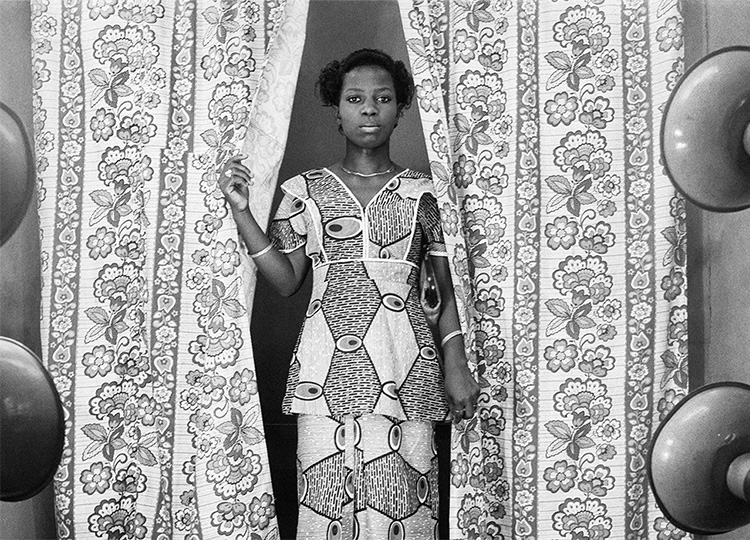Autograph’s current exhibition is the first to display a series of remarkable portraits from Abi Morocco Photos in Lagos, capturing the rich style and joyous spirit of Nigeria in the 1970s. As part of the exhibition, photographer Amaize Ojeikere – son of the renowned photographer J.D. ‘Okhai Ojeikere – reflects on the state of photographic and archival practices in Nigeria through his ongoing work preserving the legacy of his late father’s archive.
The exhibition, Abi Morocco Photos: Spirit of Lagos is on display at Autograph until 22 March 2025.
“All these hairstyles are ephemeral. I want my photographs to be noteworthy traces of them.”
- J.D. ‘Okhai Ojeikere, 1930 – 2014
Every photographer is a storyteller and a custodian of history.
I grew up living with my father’s archive which was originally kept in my childhood bedroom. As a child, I did not know what these records were, but it was clear to me that they were my father’s treasure. His negatives, dating back to the 1950s, were carefully arranged in a cupboard with a bank of drawers. Each drawer had an array of negatives, kept in jackets created by halving small white or brown envelopes annotated with information on its content such as where and when the image was taken, and the names of anyone featured. This is how I came to understand and appreciate the manner of a methodological process for keeping images intentionally in place, in a manner that allows the images to be accessible for reference, research and learning purposes.
Archives are an invaluable treasure for any society. Collections of historical documents or records (including photographs) provide valuable information and insight about a place, an institution or a people. A historical record in pictures keeps graphic information of a society over time; it forms a part of the society’s historical narrative, which shapes identity. A culture of preservation is a fundamental requirement to making this possible. The works of notable African photographers – such as, George S.A. DaCosta, Jonathan Adagogo Green, Solomon Osagie Alonge, Felix Akinniran Olunloyo, Peter Obe, Tam Fiofori, Malick Sidibé, Seydou Keïta, James Banor, and J.D. ’Okhai Ojeikere, to mention but a few – can be seen today because they were preserved.
After the first permanent photograph was taken in 1826 by French inventor Joseph Nicéphore Niépce, several other inventions have followed in the history of photography. Notable among them were those made by the French painter and chemist, Louis-Jacques-Mandé Daguerre, William Henry Fox Talbot, George Eastman and Oskar Barnack.
Early in the 19th century, Nigeria and the rest of Africa began to embrace photography. Several photographic studios and darkrooms were established in major cities of Africa including Lagos, Ibadan, Kaduna, Jos, Dakar, Bamako, Addis Ababa, Johannesburg, etc. Most photographs were taken in black and white and, later, in colour. The majority of photographers processed their black and white films in their darkrooms and kept a good record of their negatives, using imported negative holders.
With the introduction of the Quick Service System (QSS) by colour labs, most photographers began to rely on their services, and there was a shift from the use of black and white film to colour. Gradually, the number of darkrooms began to dwindle. Today, there does not seem to be a single functional commercial black and white darkroom in Nigeria. Despite this shift in medium, photographers still largely kept their negatives.
The advent of digital photography in the early 2000s began to put pressure on photographers, forcing them to decide what to do with their negatives as they would also need to create space for their new processing acquisitions such as computers, printers, external hard drives, etc. With more photographers working digitally these days, it is not uncommon for the negatives of a photographer to be discarded or destroyed for lack of space and for lack of interest due to the societal shift to digital photography. This is a sad reality, as the importance of preservation in photography cannot be overemphasised.
Preservation is the process of properly storing photographs and negatives in a place where they can be protected from elements that can damage them. Such preservation processes can be challenging within Nigeria and many other African countries due to the heat and humidity of the tropical weather. Lack of knowledge in preservation and conservation can be a major reason archives cannot be kept or sustained.
For analogue archives to survive, photographers on the continent must create processes that will address the challenging weather conditions. One of the best ways to preserve photographs and negatives is to scan and digitise them, and store them on hard drives, ensuring images made yesterday can last a lifetime. Hard drives can become damaged or corrupted, so it is good practice to make multiple copies of the hard drives, and use cloud storage as an offsite backup to mitigate physical loss or damage. Such requirements may not come cheap for the average Nigerian photographer. Nevertheless, the importance of photographic archives is not diminished, and Nigerian photographers need to seek affordable means to preserve their images if they wish their archives to last for future generations.
Today, by providence, the responsibility of managing and caring for my father’s archive rests upon my shoulders. He had a simple but effective method of preservation. Some of the negatives are still in the same envelopes after 50 years. These negatives are mostly still in good condition, although some have been lost due to weather damage and rodents. The archives continue to be an important resource for scholars, museum owners and custodians of culture all over the world.

Ojeikere lives and works in Lagos, Nigeria. His photographic career has spanned over two decades, beginning under the tutelage of his father, J. D ‘Okhai Ojeikere, who gifted him his first camera (A Canon D70, 35mm SLR camera) as a graduation present.
Ojeikere is responsible for the photographic archives left by his father, and continues to play a major role in the management of FOTO OJEIKERE, a photography company set up in 1975 devoted to providing high quality photo services. He has exhibited his work internationally.

31 Oct 2024 - 22 Mar 2025
Free exhibition





Banner image: J.D. ‘Okhai Ojeikere, Untitled Koroba HD 936/1976. © J.D. ‘Okhai Ojeikere.
Images on page: 1) J.D. ‘Okhai Ojeikere, Untitled Roundabout HD 443/1974. © J.D. ‘Okhai Ojeikere. 2) J.D. ‘Okhai Ojeikere, Untitled Koroba HD 936/1976. © J.D. ‘Okhai Ojeikere. 3-5) Images courtesy of Karl Ohiri & Riikka Kassinen / Lagos Studio Archives, 2023.
About the author: Photo of Amaize Ojeikere by Eno Eseneyen.
Exhibition: Abi Morocco Photos, Aina Street, Shogunle, Lagos [detail], 1979. Courtesy Lagos Studio Archives. © Abi Morocco Photos.
Autograph is a space to see things differently. Since 1988, we have championed photography that explores issues of race, identity, representation, human rights and social justice, sharing how photographs reflect lived experiences and shape our understanding of ourselves and others.